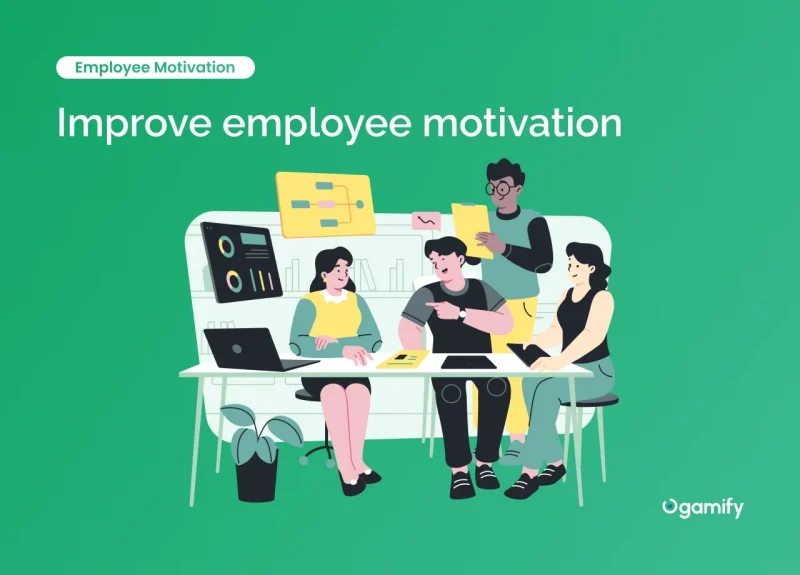Why is employee motivation at work important?
Employee motivation is essential for creating a positive work environment and achieving organizational success. Employee motivation at work is critical because it drives productivity, job satisfaction, and overall performance.
A workforce driven by motivation is prone to being actively involved and dedicated to their tasks, leading to increased job satisfaction and a more favourable workplace environment. They are generally more willing to work hard to achieve their goals, and tend to take a proactive and innovative approach to problem-solving.
Conversely, low motivation levels can lead to decreased productivity, increased absenteeism, and a high turnover rate, negatively impacting the organization’s bottom line.
What motivated employees even mean?

Motivated employees refer to individuals who are driven to perform their job responsibilities and achieve their career goals. These employees are enthusiastic and engaged in their work and put in extra effort to deliver high-quality results. They are essential for the success of any organization, as they are more productive, efficient, and innovative. There is an increased probability that they will remain with the company long-term and help to improve employee retention rates.
To keep employees motivated, companies need to implement effective employee motivation techniques, such as appreciation of the employee, team-building events, professional development opportunities, and creating a healthy work environment that fosters intrinsic motivation.
How to increase employee motivation and engagement?
Provide Feedback and Open Communication

Providing feedback and open communication is essential to increase employee motivation. By offering constructive feedback, employees can identify areas of strength and areas for improvement, leading to increased engagement and productivity. Additionally, open communication fosters transparency, trust, and accountability within the organization.
To implement these practices, companies should establish clear channels for feedback and communication, such as regular one-on-one meetings or team feedback sessions.
It is also essential to ensure that feedback is timely and specific. Employees should be given feedback promptly after completing a task or project, highlighting their successes and areas for improvement. This allows employees to address issues quickly, make necessary changes, and continue to grow and develop their skills.
Share a Gratitude – recognize good job and effort

Recognizing employees for their hard work and effort is crucial for creating a positive workplace atmosphere and increasing employee motivation. Expressing gratitude for a job well done can boost morale, improve job satisfaction, and ultimately lead to better organizational results. Companies can implement various methods, such as employee recognition programs, verbal or written acknowledgements, and other incentives.
A simple “thank you” can significantly make employees feel valued and appreciated for their contributions. Employees who feel recognized and respected are likelier to remain engaged, motivated, and committed.
Encouraging a culture of gratitude and recognition will make staff feel more valued and motivated to work collaboratively towards the company’s goals. Additionally, companies should encourage team members to express appreciation and recognition towards one another.
Encourage your employees to have a healthy lifestyle

Encouraging employees to adopt a healthy lifestyle can benefit the individual and the organization. A healthy lifestyle can improve energy levels, reduce absenteeism, and increase productivity, leading to a more engaged and motivated workforce. To encourage a healthy lifestyle, companies can implement various methods such as wellness programs, health benefits, and promoting work-life balance.
One effective method is to implement a wellness program that offers various resources and incentives to employees. This includes gym memberships, healthy snacks, and mental health resources.
Promoting work-life balance is also crucial for encouraging a healthy lifestyle. By encouraging employees to take regular breaks, providing opportunities for professional development, and offering flexible work arrangements, companies can create a work environment that supports the overall well-being of their employees.
Provide opportunities for development

Providing career advancement prospects is essential to creating a motivated and engaged workforce. Employees who feel they have opportunities to learn and grow are likelier to stay with their company and perform at a higher level. Investing in employee development can help a company stay competitive by keeping up with new technologies, trends, and industry standards.
One effective way to provide development opportunities is by offering regular training sessions or workshops that provide employees with new skills and knowledge. Additionally, offering mentorship programs can be a great way to provide employees with personalized guidance and support in their career development.
Providing opportunities for development also involves creating a culture that values learning and growth. This can be done by celebrating employees who pursue further education or certification, offering recognition for those who demonstrate new skills or knowledge, and encouraging employees to share their learning experiences with their peers.
Encourage organizational transparency and trust

Encouraging organizational transparency and trust is crucial for fostering a positive work environment and increasing employee engagement. When leaders are transparent about the company’s goals, challenges, and decision-making processes, staff feel more connected to the organization and are more likely to trust their leaders.
Trust is essential for building strong relationships between employees and leaders and can help improve collaboration, communication, and productivity. By encouraging transparency and trust, leaders can create a workplace atmosphere where employees feel valued, supported, and motivated to contribute to the organization’s success.
Establish small achievable, and quantifiable objectives

When employees have clear goals that they can work towards, it helps to provide a sense of purpose and direction, ultimately leading to increased motivation and productivity.
As a leader or manager, it’s essential to take the time to set objectives that are specific, measurable, achievable, relevant, and time-bound (SMART). This helps to ensure that the goals are realistic and attainable and that progress can be tracked and measured along the way.
By breaking down larger objectives into smaller, more manageable tasks, team members can feel a sense of accomplishment as they work towards their goals. This can also help build confidence and increase employee motivation as they can see progress towards achieving their objectives.
Foster teamwork

Collaborative efforts among employees towards shared objectives can yield greater accomplishments than what could be achieved individually. Not only does teamwork improve productivity, but it also creates a sense of community and belonging among colleagues.
To foster teamwork, creating an environment where communication is encouraged and collaboration is embraced is essential. One way to do this is by organizing team-building activities that help employees build trust and develop relationships with one another. Another way is ensuring that all team members understand their roles and responsibilities and have the necessary resources to accomplish their tasks.
By fostering teamwork, employees feel valued and appreciated, which leads to increased job satisfaction and improved morale and can boost motivation in the workplace
Take frequent and scheduled periods of rest

Frequently scheduled rest periods can be critical in today’s fast-paced and competitive work environment. Often, staff feel the pressure to keep working non-stop, sacrificing their well-being and eventually leading to burnout. This can lead to decreased job satisfaction, absenteeism, and lower productivity.
Encouraging employees to take breaks throughout the day, whether for a quick walk, a chat with colleagues, or simply stepping away from their desks, can help reduce stress levels and increase focus when they return to their tasks. Frequent and scheduled rest periods can also help prevent decision fatigue, which occurs when employees become mentally exhausted and cannot make sound decisions.

One of the keys to giving effective feedback is to ensure it is specific and actionable. Avoid making general statements or criticisms difficult for employees to act on. Instead, focus on specific behaviours or actions that need improvement. Be sure to provide concrete suggestions for how employees can improve; this will give them a clear roadmap for making positive changes.
Another important aspect of giving effective employee feedback is ensuring it is timely. Don’t wait until an annual review to provide feedback. Instead, provide real-time feedback so employees can improve and see results quickly. This can also help to build trust and enhance communication between you and your team members.
Lastly, it’s essential to deliver feedback respectfully and constructively. Avoid being overly critical or negative; instead, provide feedback in a supportive and encouraging way. Remember that the ultimate goal is to help employees improve and succeed, so focus on giving helpful and actionable feedback.
Remote work and flexible working hours

Remote work and flexible working hours have become increasingly popular in recent years, and for a good reason. Not only do they provide employees with greater freedom and autonomy over their schedules, but they also offer a host of benefits for employers.
One of the main advantages of implementing remote work and flexible working hours is that it can improve employee motivation. Employees who work from home or outside of traditional office hours often feel more empowered and in control of their work. This can increase workplace contentment and greater fulfilment in their role.
Additionally, remote work and flexible hours allow employees to balance their personal and professional lives better, reducing stress and boosting overall well-being. Employers can create an engaged workforce better equipped to meet the demands of today’s fast-paced business environment by giving your team members the flexibility they need to succeed.
Promote innovation and creativity

Innovation and creativity must be encouraged for a business to succeed over the long term and maintain its competitive edge. It entails fostering an atmosphere that motivates staff to think creatively, explore novel concepts, and offer original solutions to problems. Organizations may unleash the full potential of their workforce and promote a culture of constant development and progress by encouraging innovation and creativity.
Promoting creativity requires developing a work environment where fresh ideas are valued and rewarded, regardless of how they turn out. It entails motivating staff members to question the norm, take calculated risks, and push limits. This may be done by creating a welcoming workplace where staff members can express their thoughts and opinions without worrying about being judged or criticized.
Award both individuals and teams

Giving prizes to both people and teams is an effective way to acknowledge and promote excellence in performance within an organization. Organizations may promote an excellence, motivation, and cooperation culture by recognizing the achievements of people and teams. Here are some ways that rewarding both individuals and teams may be beneficial:
Individual Achievements Recognition:
Recognizing someone for their successes is vital since it brings attention to their special talents, contributions, and efforts. Organizations show their appreciation for employees’ exemplary performance and dedication by giving out awards to specific people. Individual motivation, work happiness, and general involvement can all increase due to this acknowledgement. Additionally, it conveys the idea that every person’s efforts are appreciated and crucial to the firm’s achievement.
Recognizing group accomplishments:
Complex activities must be completed collaboratively to meet corporate objectives. Organizations honor and celebrate the teamwork that produced remarkable results by presenting awards to winning teams. The significance of teamwork is reinforced by this appreciation, which also develops a sense of camaraderie and collaboration among workers.
When giving out prizes to teams, it’s crucial to consider their combined efforts, level of cooperation, and organizational influence. This may be finishing a job on time, beating tight deadlines, or producing outstanding outcomes as a team. In addition to enhancing team morale and cohesiveness, acknowledging teams also emphasizes the value of cooperating to achieve a common goal.
Engage staff in decision-making

An effective strategy for including staff in decision-making is to engage them in the process of making crucial decisions and deciding the organization’s course. It goes beyond the typical top-down decision-making process and allows employees to offer their knowledge, insight, and ideas.
Staff members feel a feeling of ownership and responsibility for the outcomes when they participate in decision-making. They are inspired to actively engage, take the lead, and give their all to the organization’s goals because they feel a feeling of ownership. Additionally, it encourages a stronger sense of devotion to the success of the company and a closer connection to their job.
Additionally, including employees in decision-making draws on the organization’s aggregate wisdom and different viewpoints. Employees contribute distinct perspectives and experiences that can result in more creative problem-solving, inventive solutions, and improved decision-making. Organizations may use the knowledge and suggestions of their workers by adopting a collaborative approach to decision-making, leading to more effective and informed judgments.
Boost workplace motivation now

Ogamify is a business gamification platform that enhances employee engagement, motivation, and productivity. The app utilizes game design elements and techniques to improve performance and help people grow.
You can motivate your team to do anything you want by personalizing tasks, challenges, and rewards. And build a unique company culture that is based on growth and creating healthy competition.
Check Ogamify now! 👉https://ogamify.com/
Conclusion
To sum up, employee engagement and motivation in the workplace are crucial for ensuring positive outcomes and retaining motivated employees. Implementing employee recognition programs, encouraging a healthy lifestyle, providing career advancement prospects, and encouraging organizational transparency and trust are just a few employee motivation techniques that can increase motivation and boost energy levels.
Building a healthy work environment, creating healthy competition, and promoting career paths can also help employees feel excited about their work and increase their job satisfaction. By prioritizing employee engagement and motivation, HR leaders can create a workplace culture where team members are on the same page, understand company objectives, and are motivated to give their best effort towards achieving measurable goals.
FAQ
What can happen if employee motivation is low?
If employee motivation is low, organizations will experience decreased productivity, increased absenteeism, and a high turnover rate. This can have a significant negative impact on the organization’s bottom line.
How can increased employee motivation benefit an organization?
An organization with a highly motivated workforce will likely see increased productivity, job satisfaction, and overall performance. It can also lead to proactive and innovative problem-solving and increased employee engagement.
What is employee motivation?
Employee motivation is key to creating a positive work environment and achieving organizational success. It is the drive within each individual that encourages them to perform their best work and reach their goals.
How can a team increase employee motivation?
– Clearly communicate goals and expectations.
– Recognize and reward achievements.
– Provide growth and development opportunities.
– Foster a positive work culture.
– Empower autonomy and decision-making.
– Offer regular feedback and coaching.
– Promote work-life balance.
Understanding individual needs and adapting strategies is crucial for success.
How do managers increase employee motivation?
Managers can increase employee motivation by effectively communicating goals, recognizing achievements, providing growth opportunities, fostering a supportive environment, empowering autonomy, offering feedback and coaching, and promoting work-life balance.


